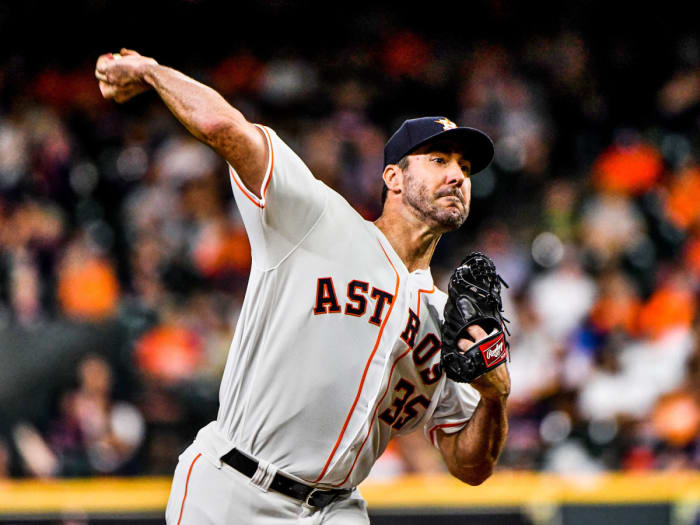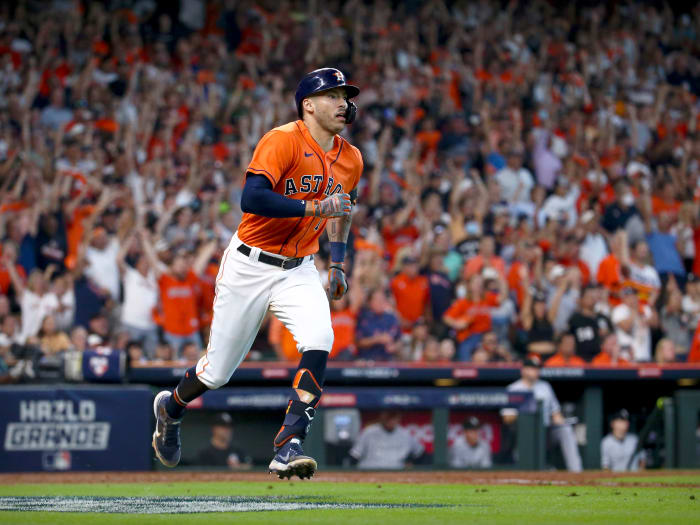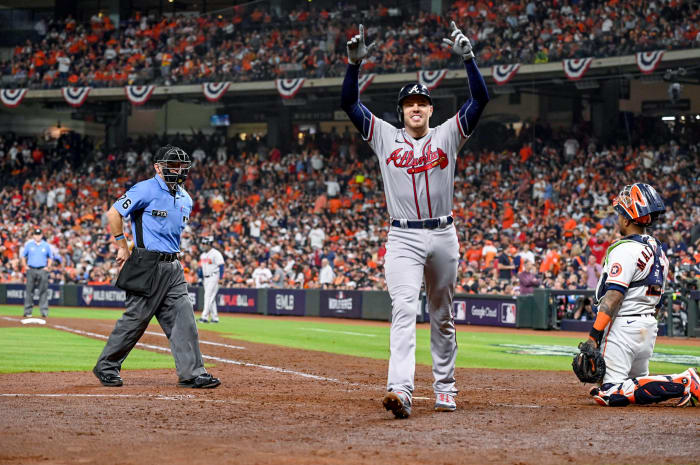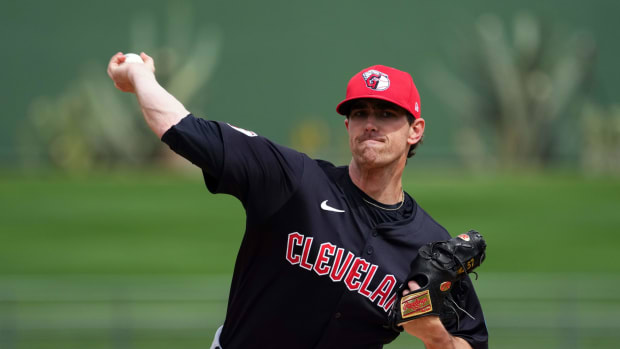Lingering Questions As MLB Lockout Puts Game on Hold
Welcome to the first week of MLB’s first labor stoppage in 26 years. If you have questions about what got us here, Sports Illustrated's Stephanie Apstein has a handy primer for you right here, and Tom Verducci has an overview of what’s at stake here. But there’s another category to catch up on: After the chaotic week of free agency that was crammed in before the lockout, a lot has changed in the competitive landscape, and it’s now (temporarily) frozen like this. So here’s a rundown of some of the new questions that baseball will face when it returns—whenever that may be.
Is there anything that can happen during the lockout?
Not really! As you probably already know, there’s a freeze on transactions involving major league players, which includes both free-agent signings and trades. (Here, “major league player” refers to anyone who is a member of the MLBPA, which means anyone who is on a 40-man roster—minor league signings can still take place. In fact, a few happened Thursday, though, naturally all of these moves will look quite small.) The 30-day posting window for free agents from Japan has frozen, too: Seiya Suzuki, the top outfielder who was posted on Nov. 22, will see his window open back up whenever there’s a labor resolution, so he can eventually get a full 30 days of negotiating with MLB teams.
But teams can move forward with other, nonplayer-related activities, since there are no restrictions on interviewing or hiring for coaching or front-office positions. Which is to say that, yes, the Mets’ search for a manager can still continue apace.

Justin Verlander and the Astros never finalized their two-year, $50 million deal—even though it was first reported two weeks ago.
Greg Nelson/Sports Illustrated
What about moves that were reported—but not made official?
They have to wait. Even if a deal was right by the finish line at 12:01 a.m. ET on Thursday, if it wasn’t completely sewn up, it’s on ice right now. There are a few in this category. The Padres’ four-year, $20 million contract with pitcher Nick Martinez was not finished, and Jordan Lyles did not have a chance to complete the physical needed for his one-year, $7 million signing with the Orioles. Most intriguingly, Justin Verlander and the Astros never finalized their two-year, $50 million deal—even though it was first reported two weeks ago. (That’s quite different from the others mentioned here: Martinez’s and Lyles’s deals broke just hours before the deadline as teams scrambled to get them done.) The Astros have stayed mum on the situation, although they did appear to clear a roster spot for Verlander. But he wasn’t on their 40-man when the lockout came down, which means that, technically, he’s still a free agent.
Will these players choose not to sign with the teams they had attached themselves to before the lockout? It’s extremely unlikely. But it’s worth noting: These deals aren’t official, these players are still free agents and there’s nothing that can change that until the league is back open for business.
And now on to the landscape set up by all the moves that were official.
What does Carlos Correa’s market look like?
MLB crammed a lot of action into just a few weeks. (Twenty-six of SI’s top 50 free agents are now off the market.) Yet baseball’s top potential signing remains available: What will become of Carlos Correa?
Several other free-agent shortstops have already gone to new homes: Corey Seager (Rangers), Marcus Semien (Rangers) and Javier Báez (Tigers). All have signed for more money or for longer than was expected—which makes it likely that Correa will, too. Here’s each shortstop with two popular contract projections, via MLB Trade Rumors and FanGraphs:
| MLB Trade Rumors | FanGraphs | Actual Contract | |
|---|---|---|---|
Corey Seager | 10 years, $305 million | 8 years, $240 million | 10 years, $325 million |
Marcus Semien | 6 years, $138 million | 4 years, $120 million | 7 years, $175 million |
Javier Báez | 5 years, $100 million | 4 years, $80 million | 6 years, $140 million |
Carlos Correa | 10 years, $320 million | 9 years, $297 million | ??? |
And the fact that Texas picked up Seager and Semien (with a plan to accommodate both by moving Semien to 2B) means that this landscape is far more interesting than it might have been otherwise. The free-agent market has cleared three of its top five shortstops—but only two teams have actually been able to fill their need at the position.
So who’s left? The Astros—Correa’s old team—are one obvious choice, though it seems unlikely that they’re willing to pay him enough long-term to keep him in Houston. The Yankees are another, but they, too, have been very quiet so far about participating in the high-end shortstop market. Meanwhile, the Red Sox will have a need for the position soon (Xander Bogaerts is a free agent after 2022), and the Phillies could greatly stand to upgrade from Didi Gregorius. (The Dodgers looked like a potential spot after losing Seager, but they do have a shortstop in Trea Turner, and their infield might look quite crowded after re-signing super-utilityman Chris Taylor.) Then there are other clubs who are perhaps not as obvious but may slip in the race after all: Cardinals? Nationals jumping into the next phase of their rebuild?
With a player as talented as Correa, all sorts of teams should be incentivized to pick up the phone. And when one of them eventually works something out after the lockout, expect it to be for at least 10 years and well more than $300 million.

Correa, the best of this year's loaded class of free agents, remains available to be signed when the MLB lockout ends.
Troy Taormina/USA TODAY Sports
Which team improved the most before the lockout?
It’s hard not to go with the Rangers. (Spending half a billion dollars will do that.) Adding Seager at shortstop, Semien at second base, Jon Gray in the rotation and Kole Calhoun in the outfield should make this team considerably better in 2022 … but that’s almost beside the point. The Rangers still have a long way to go, and so these moves were not about winning next year so much as they were about setting the team up to contend later, in '23 and '24. Remember: Texas lost 102 games last year! Even half a billion dollars can’t make that a playoff team right away. The Rangers' rotation still looks somewhat rough, and they’re waiting on some prospects to keep developing. But they grabbed these key free agents now to lock them in for the long haul, and in the process, they gave themselves the best middle infield in baseball. So even if Texas seems unlikely to make the playoffs next year—though, hey, you never know—it’s still done enough to qualify as most improved. (Though, to be fair, there’s a whole lot of room to improve when you're starting at 60–102.)
Other clubs who have had a commendable offseason so far:
• The Tigers, who addressed their biggest needs with a shortstop (Báez), starting pitcher (Eduardo Rodríguez) and catcher (Tucker Barnhart).
• The Mets, who landed a pitcher you may have heard of and remade their outfield.
• The Giants, who boosted their thin rotation with Anthony DeSclafani, Alex Wood and Alex Cobb, as well as getting a qualifying offer accepted by first baseman Brandon Belt. And the Marlins, who extended the crown jewel of their young rotation, Sandy Alcantara, and gave him a new batterymate in one of the best defensive catchers in the game, Jacob Stallings, along with getting a bat and outfield presence in Avisaíl García and trading for veteran infielder Joey Wendle, who made his first All-Star team last season.
How much will the A’s sell?
The A’s have become masters of a sort of brief retool that is not a rebuild. They’re excellent at pulling off trades designed to reload the team for success in just a year or two—never letting themselves get too far away from contention.
This winter seemed like it would be a great example of that: It sounded likely that they would trade first baseman Matt Olson or third baseman Matt Chapman and perhaps one of their starting pitchers, too. But then free agency started, and the rest of their division got a whole lot more competitive in a hurry. The Rangers, Mariners and Angels have all made big moves that push them closer to the reigning AL champion Astros, who have won the division in four of the last five years. Which leaves the A’s in an interesting spot: Does it make sense to trade even more than they originally might have planned?
It very well might. The free-agent market for good starting pitching emptied out very quickly; Oakland has a trio of solid, tradable starters (Chris Bassitt, Frankie Montas, Sean Manaea), and it seems reasonable to think that the team could command some serious packages in return. So perhaps 2022 will look duller than expected for the A’s—but in service of making the outlook that much brighter for '23 and '24.

It remains hard to imagine Freddie Freeman signing with any team other than the Braves. And yet, it's surprising that Atlanta didn't re-sign him before the lockout began.
Greg Nelson/Sports Illustrated
What will become of Freddie Freeman?
As recently as two weeks ago, this question would have seemed almost silly: He’ll re-sign with the Braves, of course, because how could he go anywhere else? Yet the CBA expired, the lockout came and Freeman was still a free agent.
He’s spent his entire career with the Braves, including a World Series title in 2021 and an MVP in '20. He’s been open about his desire to remain in Atlanta: “I think everyone in this room knows I want to stay here,” he said when asked about his future with the team during the World Series, and there were indications that the interest was mutual from the Braves. Now, there’s no reason to expect that either side has changed its position on that just yet—but the fact remains that no deal has been struck, and until there is, Freeman will be one of the most talented players available.
Could the Yankees target him, instead of a shortstop, as their big-name signing? Would the Dodgers add him to their loaded roster? It still seems likeliest that he remains with Atlanta. But that it hasn’t been done yet opens up an opportunity for other clubs to dream for however long the lockout lasts—and, whenever baseball resumes, an opportunity for them to pounce.
More MLB Coverage:
• Inside Baseball's Dangerous Game of Chicken
• Our No-Nonsense, Cut-the-Crap Guide to MLB's Labor War
• Tigers Make Risky, Yet Sensible Choice to Sign Javy Báez
• Rangers' Historic Spending Spree Probably Won't Pay Immediate Dividends
• The Sure Thing: Why the Rays Extended Baseball's Next Phenom


































